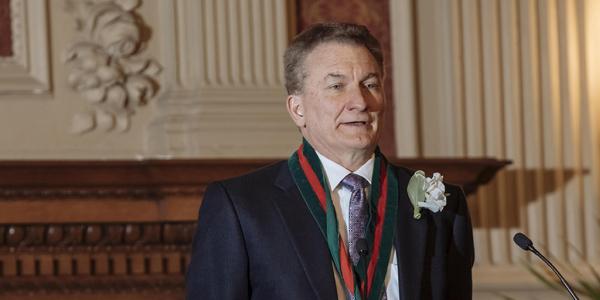Geophysicist and seismologist travels to remote areas to answer fundamental questions about our planet
Douglas Wiens was installed as the Robert S. Brookings Distinguished Professor in Arts & Sciences at a ceremony held Feb. 21 in Holmes Lounge at Washington University in St. Louis. He is the second faculty member to hold this professorship, which was established in 2006.
Wiens specializes in imaging the Earth’s interior and studying unusual earthquakes and icequakes with seismic waves.
The professorship is named in honor of Robert Somers Brookings, chairman of the Board of Trustees at Washington University from 1895-1928 and founder of the Brookings Institution in Washington, D.C.
“Endowed professorships recognize our faculty who have made great contributions to scholarship, our educational mission, and to service,” Chancellor Mark S. Wrighton said. “Professor Wiens is a distinguished intellectual who has excelled in all three areas, and I am delighted that his name will now be associated with such a prominent figure in Washington University’s history.”
Wiens was introduced by Barbara Schaal, dean of the Faculty of Arts & Sciences and the Mary-Dell Chilton Distinguished Professor. “Douglas Wiens has made tremendous contributions as a member of the Arts & Sciences’ faculty, and it is a distinct pleasure to be able to honor him in this way,” Schaal said. “He is a highly-accomplished and experienced researcher whose work is bringing to light critical information about our planet.”
Schaal summarized Wiens’ research, commenting that he has led several ocean bottom seismograph deployments to image how magma is produced beneath volcanic island chains and oceanic spreading centers and has traveled to Antarctica eight times to deploy seismographs with the goal of better understanding the physics of ice flow and ice loss there.
Wiens then spoke about recent work in Antarctica that helps to address one of the most important questions of our time: the rise in sea level that can be expected as the world warms and the ice covering western Antarctica melts. Computer models suggest the ice on West Antarctica, which, unlike that on East Antarctica, lies below sea level, could melt away in a few hundred years.
“We know this happened several times in history, and so we believe this will happen again if global temperatures rise very much. The melting of this ice sheet will add about five meters to global sea level, putting every coastal city in danger,” Wiens said.
He then went on to describe two research findings that suggest that a fortuitous interaction between the solid earth and the overlying ice that suggest that the melting might not follow the computer model perfectly.
The first finding is that the Whillens ice stream in West Antarctica is slowing down. The only ice in Antarctica that melts is the ice that makes it to the coastlines, he said, and so it is important to “understand what controls how fast ice streams that carry it there are moving.
“We’ve discovered that the Whillens ice stream’s movement is controlled by ‘sticky spots’ on its bottom. Over the last couple of decades the stream has been slowing down because something is increasing the stickiness of these spots. We believe the base of the ice stream is drying out, so the ice can no longer glide on a layer of water,” Wiens said.
The second discovery is that the land in West Antarctica is rebounding more rapidly than expected as ice is lost. Computer models that knit together gravity, elevation and seismic measurements from seismic stations suggest that ice loss has been underestimated by about 10 percent but also that the land is popping up faster than expected as it sheds the burden of ice.
The reason, Wiens said, is that the mantle rock under West Antarctica is less viscous than the mantle elsewhere and flowing back in underneath the crust as the crust rises.
In models with a low viscosity mantle, the land, currently depressed below sea level, pops up above sea level and is no longer undermined by ocean water. This fortuitous interaction between the solid earth and the ice may mean that the ice sheet remains stable for longer than it otherwise would.
Wiens earned a bachelor’s degree in physics from Wheaton College in Illinois and a doctorate in geological sciences with an emphasis in seismology at Northwestern University. He joined the faculty at Washington University when he was only 25.
Wiens served as chair of the Department of Earth and Planetary Sciences from 2008-2014. He was elected a Fellow of the American Geophysical Union in 2007 and is currently president of the seismology section of the AGU. He is chair of the board of directors of the Incorporated Research Institutions in Seismology, a research consortium with an annual budget of more than $25 million.
He served as a visiting faculty member at the University of Tokyo in 2014 and also received the Robert L. And Bettie P. Cody Award in Ocean Sciences from the Scripps Institution of Oceanography in that year.
About Robert Somers Brookings
“Robert Brookings guided the progress of Washington University with an indefatigable spirit and great business acumen,” Chancellor Wrighton said.
Brookings, whose career was made at Cupples and Marston, a woodenware and willowware wholesale business in Saint Louis, became a member of the Washington University Board of Trustees in 1891.
A year later, Brookings played a role in choosing the site for a new campus, which he identified while riding on horseback west of the city. He helped secure funding for the 100 acres that would become the university’s Hilltop Campus. In 1895 he accepted the board presidency and remained on the board for 33 years, giving nearly all of his time and much of his fortune. In 1909, he gave the university a 50-acre tract of land south of Forsyth, now called the “South 40.”





